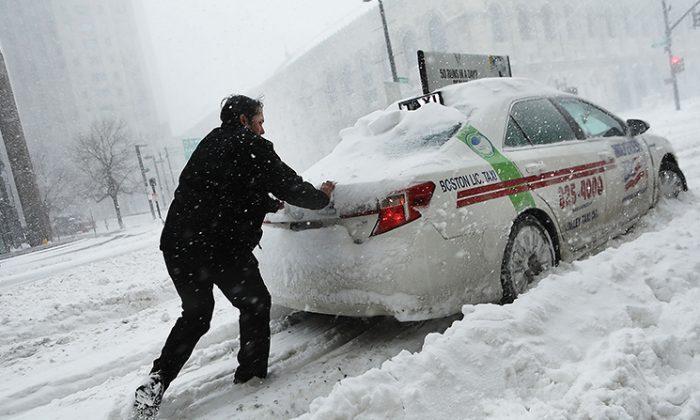The “Bomb Cyclone,” also being called “Winter Storm Grayson,” exploded over the northeastern United States on Dec. 4, powered by the combined forces of low barometric pressure, frigid air, screaming winds, and the highest tides of the year, influenced by last week’s “Supermoon.”
This hyper-powered quartet of natural forces combined to create over a foot of snow, single-digit temperatures, and rivers of semi-frozen slush, sometimes several feet deep on the streets of Boston and some Massachusetts seaside communities.
Nantucket, an island town off the Massachusetts coast, was hit with 76 mph winds. Similar gusts tore through the entire coastal region.
‘Supermoon’ Sends Seawater Gushing Through Streets
The Supermoon, which is a full moon which occurs when the Moon is at the closest point of its orbit around the Earth, brought record-setting high tides.According to the National Weather Service, Boston tides ran the highest since recording began in 1921, breaking the previous set during the Blizzard of ’78.
Cars were seen floating down the street in the fishing town of Chatham, Massachusetts, as walls of water 4 feet deep coursed through the streets.
https://twitter.com/kelkelly/status/948982158533824512
“It’s an unfortunate situation. We’ve never had a storm surge like this in the city. This parking lot was flooded. They can’t be salvaged. They were all under water and floating,” Gloucester Chief Administrator Jim Destino said.
Nantucket was lucky by comparison. The old whaling port only saw about three feet of floodwater. Gloucester, another historic fishing port, saw about the same.
“When we get tides, we get some that go up to 12 feet or more. We were forecasting 12.1 feet with this one, but with the surge, it got bumped up to 15 feet.
“It’s definitely historic.'”
Arctic Temperatures Increase the Misery
As if rivers of slush and feet of snow—and a high temperature of only 15 degrees—didn’t cause enough misery, after the snow passed, the temperature fell to the single digits, DailyMail reported.“There are lots of reason[s] to be concerned when you’re talking windchills of 30 to 40 below zero in some areas,” said Kurt Schwartz, director of the Massachusetts Emergency Management Agency.
In Quincy and Revere, Massachusetts, cars were also surrounded by floodwater which then froze, trapping cars in an impenetrable ice sheet.

What Is ‘Bombogenesis’?
Meteorologists began calling Winter Storm Grayson a “Bomb Cyclone” because it underwent what is called “bombogenesis”: when atmospheric pressure drops more than 24 millibars in 24 hours.This storm saw a pressure drop of 59 millibars in 24 hours between Jan. 3 and Jan. 4—which according to data compiled by Dr. Andrea Lopez Lang from SUNY-Albany and David Roth from NOAA’s Weather Prediction Center, was the largest recorded drop in that part of the Atlantic since 1976.
No Relief Forecasted
According to the National Weather Service, this storm system has brought unusually cold weather to the entire nation east of the Mississippi. The lowest temperatures (compared to average) will hit in an arc north from Ohio and east through New England.New England can expect night-time lows around zero, and even as far south as North Carolina, single digits can be seen.
The National Weather Service predicts the arctic weather will remain for the next few days.






Friends Read Free